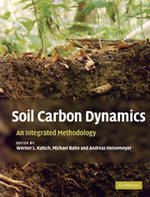 Soil Carbon Dynamics Cover
Soil Carbon Dynamics Cover
Soil Carbon Dynamics Cover
Soil Carbon Dynamics Cover
A Review of Soil Carbon Dynamics, An Integrated Methodology edited by W.L. Kutsch, M. Bahn and A. Heinemeyer (Cambridge University Press 2009)
Reviewed by Rattan Lal
This book describes methods to assess a vital natural resource: soil organic carbon (SOC) in natural and managed ecosystems. More than a billion people depend on the SOC pool to sustain their food supplies. Even so, certain areas have excess SOC that might help buffer and mitigate abrupt climate change. The significance of this book is heightened by its relevance to biodiversity, economic development, energy use, pollution abatement, and water quality.
The top meter of soil contains about 2500 gigatons (Gt) of SOC, roughly four times the biotic pool (620 Gt) and three times the atmospheric pool (800 Gt). Soil organic carbon is an important component of the global carbon cycle because it is a source and sink of trace gases and it moderates C-bearing atmospheric species. Concentrations of SOC vary in response to natural processes, but its recent and rapid variability results from agricultural management to optimize the soil nutrient pool and crop/biomass yields. Keep in mind that many details of how agriculture affects SOC are incompletely understood.
The SOC pool has been mined for plant nutrients since the dawn of settled agriculture some 10 to 13 millennia ago. Mineralization of soil organic matter, which contains about 58% SOC, releases Cu K, N, P, and Zn ions to soil water. These constituents are essential trace nutrients for corn, soybeans, wheat, and other crops. However, mineralization also emits CO2 under aerobic and CH4 under anaerobic conditions. Agriculture often entails one or more of the following: biomass burning; deforestation; drainage and subsequent disruption of natural surface- and ground-water flow patterns; fertilization; tillage; and manure spreading. Each activity can contribute greenhouse gases to the atmosphere.
1. The global SOC pool has been depleted by 60 to 100 Gt, and most agricultural soils now contain less SOC than their maximum capacity. Soils that contain 10-40 megatons SOC/hectare may capture and immobilize excess CO2 and other gases emitted by corporate and private farms, coal-burning power plants, petroleum processing, and other industries. Certain technological difficulties must be solved before large-scale CO2 storage by SOC becomes an acceptable method to ameliorate greenhouse gas emissions. At present, CO2 sequestration by SOC is hobbled by a lack of standard methodologies to measure and monitor its performance and to determine its cost-effectiveness. These issues are tractable engineering problems. Nevertheless, the idea is not accepted or even prioritized by the international community, including the very influential United Nations Framework Convention on Climate Change. (See COP-3 in Kyoto, December 1997 and COP-15 in Copenhagen, December 2009.)
The book edited by Kutsch et al. (2009) makes progress toward the goal of CO2 sequestration by SOC. The book describes several techniques to accomplish the following: measure the magnitude of the SOC pool and its change over periods of 1 to 3 years: measure the impact of root respiration on SOC; characterize litter decomposition; account for microbial mediation of SOC; and develop models that compartmentalize total SOC according to how it formed. In this context, the book is a state-of-the-knowledge compendium of methods to monitor SOC pools and fluxes and its potential role in mitigating greenhouse gas emissions.
Statements and conclusions in the 15-chapter book are supported by comprehensive literature citations and illustrated by excellent graphics and flow charts. The book is prepared by world class-professionals and addresses an important and timely theme of global significance. This multi-authored collection should be read by participants in the U.N. Millennium Development Goal, which seeks to alleviate poverty and reduce malnutrition. The book describes essential techniques for trading C credits, which creates another income stream for farmers.
Readers will find this book extremely informative about chemical, ecological, physical and physiological aspects of soils. In addition, the chapter on the Kyoto Protocol reveals matters of interest for policy makers and practitioners. However, I find the book deficient in its discussion of soil quality and the human dimensions of C sequestration in soil. The book would benefit from four more chapters. The additional material should include:
- The importance of the SOC pool in relation to agronomic production and global food security;
- The cost-effectiveness and economics of C sequestration in soil compared to storage in geological formations;
- How farmers and land managers ought to be compensated for devoting their land to enhancement of the SOC pool, and
- Strategies to promote recommended management practices that would enhance the SOC pool in ecosystems affected by intensive agriculture.